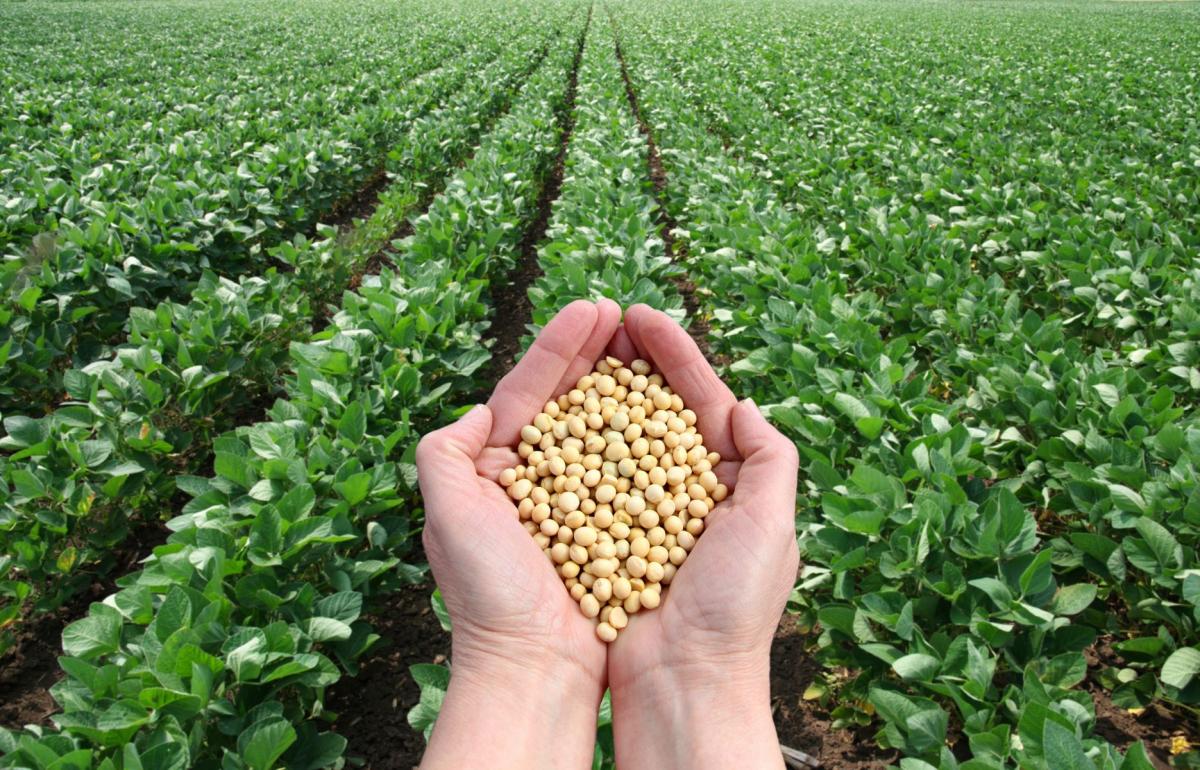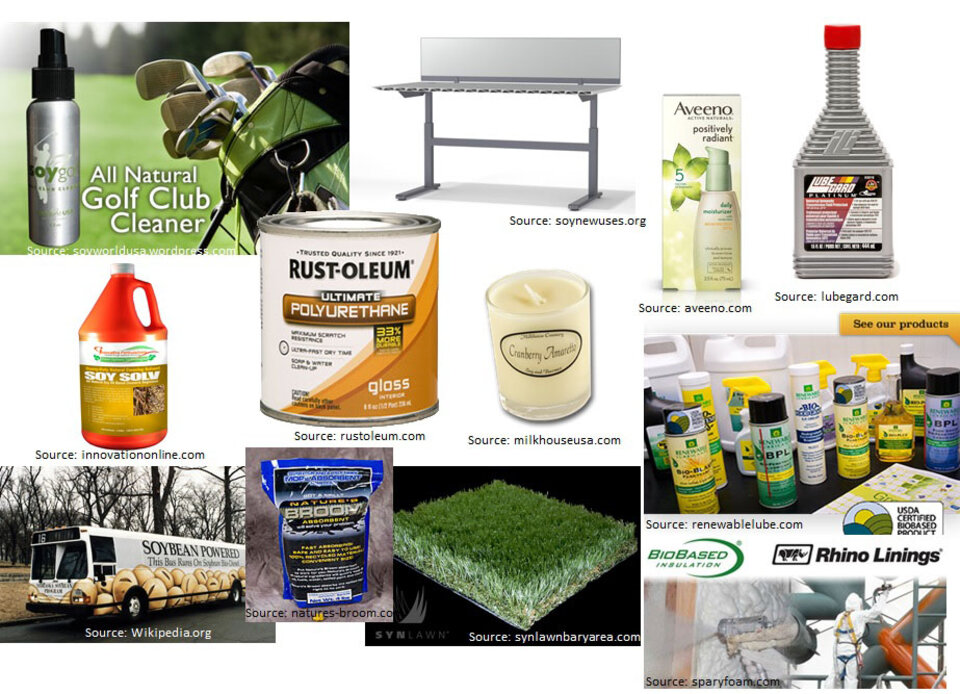YOUTH & YOUTH ACTIVITIES
Soybean Management Guide
Presented by NORTHEAST RESEARCH AND EXTENSION CENTER

Introduction
Soybeans are legumes related to peas, clover and alfalfa. Soybeans are dicots, which means they have two cotyledons. Each soybean plant produces 60 to 80 pods, each holding three pea-sized beans. Soybeans are hardy plants and well adapted to a variety of soils and soil conditions. Soybeans are slower growing than most garden beans, requiring warmer weather and about 3 to 5 months for maturity.
Cotyledon: A cotyledon stores food for the developing embryo and is the first part of the plant that emerges from the soil.
Initially, soybeans develop a main taproot, but soon after emergence numerous lateral roots branch off to produce a fibrous root system. Young soybean roots develop root nodules within a week after emergence. Rhizobium, a nitrogen-fixing bacterium enters the nodules and after ten to fourteen days are able to supply most of the plant’s nitrogen needs.
Regarding flower development, there is two main types soybeans can be classified: determinate and indeterminate. Indeterminate soybeans continue growing upward at the tip of the stem for several weeks after flowering begins lower on the stem. Upper nodes will not flower until later. Most commercial varieties are indeterminate. Indeterminate soybeans usually grow taller and do well in short growing seasons. Determinate soybean plants complete their growth in height and then produce all the flowers at about the same time and usually one-half to two-thirds as tall as indeterminate varieties.
Soybeans are generally harvested when the seeds are fully matured and turns completely yellow and dried down to 13-14% moisture. Soybeans may also be used as a green vegetable, called edamame in which soybean pods should be harvested when the seeds are fully grown but before pods turn yellow.
FACT
The flowers of soybean are very small (1/4 inch) and are white, pink or purple. They resemble the flowers of pea or clover, since the soybean is also in the legume plant family. Only about 50 to 80% of the total flowers actually produce pods.
DID YOU KNOW?
The deepest roots in soybean plants can reach down five feet or more in well drained, loose soils; although most roots are found in the upper one foot of soil.
For more basic soybean growth information, go to the National Soybean Research Laboratory.
Soybean Uses
Soybeans have historically been grown as food for millions of people and as an ingredient for livestock feed. Through research and product development, there are many industrial and food use products that use soybeans or soybean-derived products as one of the main ingredients. Since soybeans are composed of protein and oil, soybeans are available for many uses, as processors can separate soy’s components into soy protein (meal) and soy oil. Soy protein, which makes up 80 percent of the soybean primarily serves as animal feed and is incorporated in many human foods. The United States food industry uses more than 83 percent of soybean oil for cooking baking and frying. The remaining soybean oil is used in industrial applications such as adhesives, printing inks, plastics and specialty products.

Figure 1. Soybean-based products.
FOOD USES
- Whole Soybean
- Baked Soybeans
- Full Fat Flour: Bread
- Candy
- Doughnut Mix
- Frozen Desserts
- Instant Milk Drinks
- Low-cost Gruel
- Pancake Flour
- Pan Grease Extender
- Pie Crust
- Sweet Goods
- Seed
- Soy sprouts
- Stock Feeds
- Roaster Soybeans: Candy Ingredients
- Confection
- Cookie Ingredient
- Cookie Topping
- Cracker Ingredient
- Dietary Items
- Fountain Topping
- Soy Coffee
- Soynut Butter
- Soynuts
- Traditional Soyfoods: Miso
- Natto
- Soymilk
- Soy Sauce
- Tempeh
- Tofu
- Whole Green Soybean
- Soybean Oil
- Fatty Acids
- Glycerol
- Refined Soybean Oil
- Sterols
- Refined Soybean Oil
- Refined Soybean Oil
- Cookies
- Crackers
- Cooking Oils
- Creamers
- Filled Milks
- Liquid Shortening
- Margarine
- Mayonnaise
- Salad Dressing
- Sandwich Spread
- Vegetable Shortening
- Soybean Meal
- Grits
- Soy Flour
- Concentrates and Isolates (such as baby food)
- Bakery Ingredients
- Beef and Ale
- Diet Food Products
- Hypo-Allergenic Milk
- Meat Products
- Noodles
- Yeast
- Special Diet Foods
- Meat Analogs
- Food Drinks
INDUSTRIAL USES
- Refined Soybean Oil
- Anti-Corrosive Agents
- Anti-Static Agents
- Caulking Compounds
- Core Oils
- Diesel Fuel
- Disinfectants
- Dust Control Agent
- Electrical Insulation
- Epoxies
- Fungicides
- Herbicides
- Inks, printing
- Insecticides
- Linoleum Backing
- Metal, Casting/working
- Oiled Fabrics
- Paints
- Pesticides
- Plasticizers
- Protective Coatings
- Putty
- Soaps/Shampoo/Detergents
- Vinyl Plastics
- Waterproof Cement
- Wallboard
- Anti-static Agents
- Soybean Oil -Lecithin Products
- Anti-foaming Agents
- Calf Milk Replacers
- Cosmetics
- Wetting Agents
- Soybean Four and Isolate
- Adhesive
- Analytical Reagents
- Antibiotics
- Asphalt Emulsions
- Binders, wood/resin
- Cleansing Materials
- Cosmetics
- Fermentation
- Aids/Nutrients
- Films for Packaging
- Fungicides
- Inks
- Insecticidal Sprays
- Leather Substitutes
- Linoleum Backing
- Livestock Feeds
- Paints, Water-Based
- Particle Board
- Pesticides
- Plastics
- Plywood
- Pharmaceuticals
- Tape Joint Cements
- Textiles
- Texture Paints
- Wallboard
ANIMAL FEED
- Soybean Meal
- Aquaculture
- Bee Foods
- Calf Milk Replacers
- Fish Food
- Fox & Mink Feeds
- Pet Foods
- Poultry Feeds
- Protein Concentrates
- Swine Feeds
SOYBEAN HULLS
- Dairy feed
- Filter material
- High fiber breads
Source: Iowa State University
For a more complete list of products produced using soybeans, visit soynewuses.org.

Nebraska Soybean Board graciously provided the funding for the Soybean Management Guide.
Course authored by:
Amy Timmerman, extension educator; Aaron Nygren, extension educator; Brandy VanDeWalle, extension educator; Loren Giesler, Plant Pathologist Department head; Ron Seymour, extension educator; Keith Glewen, former extension educator; Charles Shapiro, emeritus extension soil scientist; Amit Jhala, extension weed specialist; Don Treptow, former graduate student